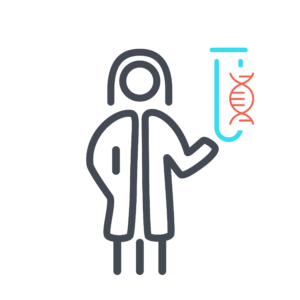CACNA1C-Related Syndrome

Table of contents
- What is CACNA1C-related syndrome?
- Key Role
- Symptoms
- What causes CACNA1C-related syndrome?
- Why does my child have a change in the CACNA1C gene?
- What are the chances that other family members of future children will have CACNA1C-related syndrome?
- How many people have CACNA1C-related syndrome?
- Do people who have CACNA1C-related syndrome look different?
- How is CACNA1C-related syndrome treated?
- Behavior and development concerns linked to CACNA1C-related syndrome
- Medical and physical concerns linked to CACNA1C-related syndrome
- Where can I find support and resources?
- Sources and References
CACNA1C-related syndrome is also called Brugada syndrome, long QT syndrome, and Timothy syndrome. For this webpage, we will be using the name CACNA1C-related syndrome to encompass the wide range of variants observed in the people identified.
What is CACNA1C-related syndrome?
CACNA1C-related syndrome happens when there are changes in the CACNA1C gene. These changes can keep the gene from working as it should.

Key Role
The CACNA1C gene plays an important role in brain cell communication and muscle contraction. It also plays a role in the heart, lungs, and smooth muscle.
Symptoms
Because the CACNA1C gene is important for brain activity, many people who have CACNA1C-related syndrome have:
- Developmental delay
- Impaired intellectual development
- Low muscle tone
- Autism
- Aggression
- Speech issues
- Seizures
- Walking and movement issues
- Vision issues
- Heart structure or function problems
What causes CACNA1C-related syndrome?
CACNA1C-related syndrome is a genetic condition, which means that it is caused by variants in genes. Our genes contain the instructions, or code, that tell our cells how to grow, develop, and work. Every child gets two copies of the CACNA1C gene: one copy from their mother’s egg, and one copy from their father’s sperm. In most cases, parents pass on exact copies of the gene to their child. But the process of creating the egg or sperm is not perfect. A change in the genetic code can lead to physical issues, developmental issues, or both.
Sometimes a spontaneous variant happens in the sperm, egg or after fertilization. When a brand new genetic variant happens in the genetic code is called a ‘de novo’ genetic variant. The child is usually the first in the family to have the genetic variant.
De novo variants can take place in any gene. We all have some de novo variants, most of which don’t affect our health. But because CACNA1C plays a key role in development, de novo variants in this gene can have a meaningful effect.
Research shows that CACNA1C-related syndrome is often the result of a de novo variant in CACNA1C. Many parents who have had their genes tested do not have the CACNA1C genetic variant found in their child who has the syndrome. In some cases, CACNA1C-related syndrome happens because the genetic variant was passed down from a parent.
Autosomal dominant conditions
CACNA1C-related syndrome is an autosomal dominant genetic condition. This means that when a person has the one damaging variant in CACNA1C they will likely have symptoms of CACNA1C-related syndrome. For someone with an autosomal dominant genetic syndrome, every time they have a child there is a 50 percent chance they pass on the same genetic variant and a 50 percent chance they do not pass on the same genetic variant.
Autosomal Dominant Genetic Syndrome
Why does my child have a change in the CACNA1C gene?
No parent causes their child’s CACNA1C-related syndrome. We know this because no parent has any control over the gene changes that they do or do not pass on to their children. Please keep in mind that nothing a parent does before or during the pregnancy causes this to happen. The gene change takes place on its own and cannot be foreseen or stopped.
What are the chances that other family members of future children will have CACNA1C-related syndrome?
Each family is different. A geneticist or genetic counselor can give you advice on the chance that this will happen again in your family.
The risk of having another child who has CACNA1C-related syndrome depends on the genes of both biological parents.
- If neither biological parent has the same genetic variant found in their child, the chance of having another child who has the syndrome is on average 1 percent. This 1 percent chance is higher than the chance of the general population. The increase in risk is due to the very unlikely chance that more of the mother’s egg cells or the father’s sperm cells carry the same genetic variant.
- If one biological parent has the same genetic variant found in their child, the chance of having another child who has the syndrome is 50 percent.
For a symptom-free brother or sister of someone who has CACNA1C-related syndrome, the sibling’s risk of having a child who has CACNA1C-related syndrome depends on the sibling’s genes and their parents’ genes.
- If neither parent has the same genetic variant causing CACNA1C-related syndrome, the symptom-free sibling has a nearly 0 percent chance of having a child who would inherit CACNA1C-related syndrome.
- If one biological parent has the same genetic variant causing CACNA1C-related syndrome, the symptom-free sibling has a 50 percent chance of also having the same genetic variant. If the symptom-free sibling has the same genetic variant, their chance of having a child who has the genetic variant is 50 percent.
For a person who has CACNA1C-related syndrome, the risk of having a child who has the syndrome is about 50 percent.

How many people have CACNA1C-related syndrome?
As of 2024, at least 100 people with CACNA1C-related syndrome have been described in medical research.

Do people who have CACNA1C-related syndrome look different?
People who have CACNA1C-related syndrome may look different. Appearance can vary and can include some but not all of these features:
- Ear defects
- Eye issues and/or wide-set eyes
- Thin upper lip
- Teeth problems
- Changes in facial features, which might not be the same in every person

How is CACNA1C-related syndrome treated?
Scientists and doctors have only just begun to study CACNA1C-related syndrome. At this point, there are no medicines designed to treat the syndrome. A genetic diagnosis can help people decide on the best way to track the condition and manage therapies. Doctors can refer people to specialists for:
- Physical exams and brain studies
- Genetics consults
- Development and behavior studies
- Other issues, as needed
A developmental pediatrician, neurologist, or psychologist can follow progress over time and can help:
- Suggest the right therapies. This can include physical, occupational, speech, or behavioral therapy.
- Guide individualized education plans (IEPs).
Specialists advise that therapies for CACNA1C-related syndrome should begin as early as possible, ideally before a child begins school.
If seizures happen, consult a neurologist. There are many types of seizures, and not all types are easy to spot. To learn more, you can refer to resources such as the Epilepsy Foundation’s website: epilepsy.com/learn/types-seizures.

This section includes a summary of information from major published articles. It highlights how many people have different symptoms. To learn more about the articles, see the Sources and References section of this guide.
Behavior and development concerns linked to CACNA1C-related syndrome
Certain genetic variants in CACNA1C only cause heart issues, such as QT prolongation (a heart rhythm disorder that causes the heart to take longer time between heartbeats) or congenital heart disease (when someone is born with heart structure defects). For these specific variants, people do not have other medical features. The people described below have Timothy syndrome type I or II, meaning that they have medical features outside of the heart issues.
Learning
Very few people with CACNA1C-related syndrome had developmental delays or intellectual disabilities, but many people had speech delays or learning challenges. Some people were non-verbal.
- 2 out of 30 people had developmental delays or intellectual disabilities (7 percent)
- 24 out of 35 people had speech delay (69 percent)
Behavior
People with CACNA1C-related syndrome had behavioral challenges, such as autism, anxiety, attention-deficit/hyperactivity disorder (ADHD), and aggression.
- 10 out of 21 people had autism (48 percent)
- 10 out of 20 people had ADHD (50 percent)
- 18 out of 31 people had aggression (58 percent)

Brain
Some people with CACNA1C-related syndrome had neurological issues, such as lower than average muscle tone (hypotonia) and seizures.
- 10 out of 33 people had hypotonia (30 percent)
- 15 out of 37 people had seizures (41 percent)

Medical and physical concerns linked to CACNA1C-related syndrome
Heart
People with CACNA1C-related syndrome had congenital heart defects, such as patent ductus arteriosus, patent foramen ovale, ventricular septal defect, hypertrophic cardiomyopathy, and tetralogy of Fallot. All people had QT prolongation (a heart rhythm disorder that causes the heart to take longer time between heartbeats).
- 13 out of 41 people had congenital heart defects (32 percent)
- 34 out of 34 people had QT prolongation (100 percent)

Other medical features
Other common medical findings included an abnormal connection between 2 fingers (cutaneous syndactyly), recurrent infections, breathing issues, precocious puberty, and dental findings.
- 45 out of 47 people had cutaneous syndactyly (96 percent)

Where can I find support and resources?
Timothy Syndrome Alliance
The Timothy Syndrome Alliance’s mission is to improve the diagnosis, treatment and care of individuals with CACNA1C-related disorders, including Timothy Syndrome and LongQT8, and to support the families and carers of those diagnosed.
Simons Searchlight
Simons Searchlight is an online international research program, building an ever growing natural history database, biorepository, and resource network of over 175 rare genetic neurodevelopmental disorders. By joining their community and sharing your experiences, you contribute to a growing database used by scientists worldwide to advance the understanding of your genetic condition. Through online surveys and optional blood sample collection, they gather valuable information to improve lives and drive scientific progress. Families like yours are the key to making meaningful progress. To register for Simons Searchlight, go to the Simons Searchlight website at www.simonssearchlight.org and click “Join Us.”
- Learn more about Simons Searchlight: www.simonssearchlight.org/frequently-asked-questions
- Simons Searchlight webpage with more information on CACNA1C: www.simonssearchlight.org/research/what-we-study/cacna1c
- Simons Searchlight Facebook group: https://www.facebook.com/groups/cacna1c

Sources and References
- Borbás, J., Vámos, M., Hategan, L., Hanák, L., Farkas, N., Szakács, Z., Csupor, D., Tél, B., Kupó, P., … & Sepp, R. (2022). Geno- and phenotypic characteristics and clinical outcomes of CACNA1C gene mutation associated Timothy syndrome, “cardiac only” Timothy syndrome and isolated long QT syndrome 8: A systematic review. Frontiers in Cardiovascular Medicine, 9, 1021009. https://pmc.ncbi.nlm.nih.gov/articles/PMC9745330/
- Timothy, K. W., Bauer, R., Larkin, K. A., Walsh, E. P., Abrams, D. J., Corcia, C. G., Valsamakis, A., Pitt, G. S., Dick, I. E., & Golden, A. (2024). A natural history study of Timothy syndrome. medRxiv. [Preprint] https://www.medrxiv.org/content/10.1101/2024.05.20.24307583v1
